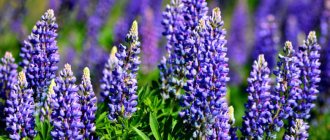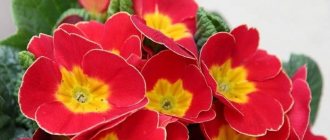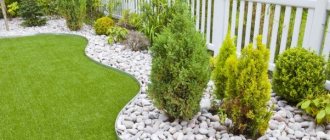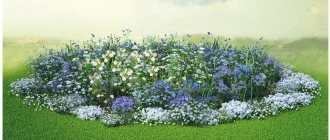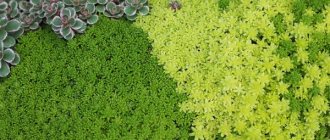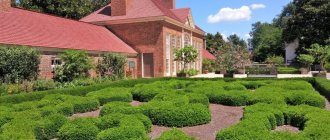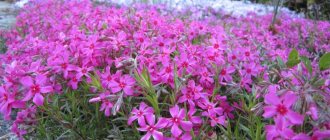The border is an important element of landscape design, giving a complete look to any composition. Along with stone, wood, plastic, and metal structures, hedges made of low-growing flowers - annuals and perennials - are very popular. This framing of flower beds, lawns, and paths looks elegant, beautiful and original. With the help of a living border, you can draw a clear border or create a smooth transition, decorate the edges of an artificial pond, a wall, or a gazebo. Border perennials are more popular and have a number of advantages over plants with a short life cycle.
Tips for selection and care
Annuals allow you to change the shape and color of the border every year - this is a plus. But every year in the spring the gardener will have to plant border plants - and this is a minus.
On the contrary, perennials free up our time at the beginning of the season, when there is already enough work. But you will have to come to terms with the fact that the design will be laid out several years in advance.
On the other hand, with a successful solution and a correctly composed composition, a perennial border will delight you every year with its color scheme.
The final decision on which flowers to plant along the paths, around the flower bed, is made by the gardener, focusing on his capabilities and preferences.
Double-sided
There is access from 4 sides. Placement: the central part of a wide path, a dividing strip on a highway. At the dacha, it is laid out as far as possible from buildings.
Evergreens - a complete list with descriptions and recommendations from a gardenerVertical gardening - from idea to implementation, choosing options according to budget and attractiveness (photo + video)
- Vertical flower beds - basic principles and rules for choosing plants and arranging a suburban area with your own hands
As for the design, tall plantings are carried out in the center. Then medium-sized plants are introduced, and finally low ground covers are planted.
It is appropriate to equip double-sided flower beds not only on a leveled area, but also on an artificially made embankment. The second option is usually used if you want to create a wide border.
Annuals for creating floral borders
Border annuals, especially seedlings planted in the ground, will delight you with flowers from early summer until cold weather. Annuals do not live long, but leave a bright mark.
We will select the best ones from a large palette of colors, so that later, combining them in various combinations, we will get a beautiful frame for your flower painting.
Catalog of annual border flowers
Of the many annual plants, the most interesting in this case are low-growing annuals that can shade and emphasize the beauty of a selected fragment of a garden plot. The best varieties of annual plants to decorate your garden borders:
Ageratum (long-flowered)
In order to get good seedlings, the seeds should be sown in the third decade of March or early April. Ageregatum begins to bloom in June, and flowering ends only in September.
Alyssum
The flower can be sown in early spring in a permanent place under the film. It will take one and a half months from the appearance of the first shoots to the start of flowering.
Pansies
In the gardening community, violet tricolor is known as the “pansy.” A characteristic feature of pansies is their beautiful, large flowers with a rich tricolor color.
Arabis rezuha
The flowering period is long, with a large number of yellow, white pink and purple flowers. Propagated by seeds. The simplest thing is to sow before winter in October. Those who are not looking for simple ways grow rhizomes through seedlings. Seeds for seedlings are sown in April.
Marigold
The ability to bloom all summer long is what explains the incredible popularity of the flower. For all their unpretentiousness and outward simplicity, marigolds amazingly transform gardens, parks, and flower beds.
Begonia semperflorens everblooming
Begonia semperflorens has several names:
- ever-blooming;
- always blooming;
- elegant. With proper care, even without pruning, Begonia Everblooming has compact and neat bushes.
Dahlia
The palette of shades of these beautiful colors knows no bounds. Gardeners love these bright flowers, which is why they sow seeds every year for seedlings to admire them all summer long.
Decorative cabbage
In creating a border it is used not only on its own, but also in a mixborder with many other colors.
Iberis
With abundant flowering, the plant is almost completely hidden under the flower cap.
Daisy
As border flowers, daisies frame paths, flower beds, borders and mixborders. The daisy grows on any soil, but blooms more luxuriantly on well-fertilized loams.
Matricaria feverfew
A light-loving plant, it requires an open, well-lit space for planting. Responsive to feeding.
Petunia
Intense flowering and the formation of a large mass of greenery requires constant replenishment of food and water. On hot days, petunia is watered twice.
Salvia sparkling (Sage salvia)
Salvia sparkling, another name is brilliant sage, is an extremely heat-loving perennial. Therefore, in our regions it is grown as an annual crop.
Cineraria maritima
The unpretentiousness and original appearance of Cineraria explain its use in the design of flower beds, flower beds, borders and other landscape elements.
Annual plants for borders
A perennial border has many benefits, but it is too permanent—the garden looks the same every year. If you want variety, you can always plant beautiful annual flowers along the edge of the path, along the fence or under the trees. There is more trouble with them, because to create a border that will please the eye from the first warm days, you will have to grow seedlings. For amateurs, this is not a problem, but a pleasure; others can buy ready-made seedlings at the market or at a garden store.
Many annuals can be planted directly from seeds into the ground, but in this case you will have to wait a long time until they sprout, get stronger and bloom. But flowers grown from seeds yourself will cost much less. Especially if you collect your seeds in the fall. In this case, you can immediately plant plants densely, without waiting for them to grow.
Bright border of petunias Source iz-town.ru
Classification of border perennials
Planting border perennials is more advantageous in terms of labor costs when caring for them. Border perennials, once planted, can grow for several years without replacement. The specific type is chosen in accordance with the intended purpose when designing the composition.
Rules for choosing perennials for forming a border
Plants for the border according to the height of the bush are divided into:
- tall, growing up to 180 cm;
- medium - in the range of 30 - 85 cm;
- low - up to 30 cm.
Border perennial flowers will grow in one place for more than one year, so it is better to draw a color plan of the future flower bed or ridge before planting. At the same time, take into account the timing of the beginning and end of flowering.
What qualities of border perennials still need to be taken into account:
- ability to grow in sun or partial shade;
- the ability to quickly fill the marked area; it is better to choose perennials with an average growth rate;
- maintaining decorative qualities in cool or rainy weather;
- the best plant height for a border is no higher than 50 cm;
- the possibility of growing together in company with other plants.
Perennial flowers and shrubs for borders
Most often, low-growing shrubs and other perennial border plants are planted to create a border. A living border looks brighter and more original in comparison with stone and bricks. Photos and names of plants will help you make your choice.
Agapanthus
This perennial has abundant foliage and inflorescences with a pleasant aroma. The plant does not require specific care.
Balsam
Another name for balsam is flame, which is associated with active and long-lasting flowering. The plant has many species, both annual and perennial.
Periwinkle
The leaves of periwinkle are distinguished by their incredible strength and vitality: their fresh appearance is maintained even under the snow.
Heather
Heather blooms in mid-summer, but the bush will show its full beauty in late autumn. The first frost will change the color of its leaves from green to burgundy and yellow.
Dianthus pinnata
The perennial pinnate carnation lays a leafy stem in the first year after planting, and begins to bloom in the second year of life.
Heuchera parviflora
Most types of heuchera are unpretentious, but this does not apply to soil requirements and lighting. The plant is contradictory: moisture-intensive and loose soil, bright sunlight and partial shade at midday.
Avens
Gravilat is so frost-resistant that in areas with mild winters warmer than minus 18, it does not change the color of the leaves until the new season.
Dicentra
The shape of the dicentra bush is similar to a fern, and the heart-shaped flowers, on bare shoots, hang in impressive clusters.
Tenacious
This herbaceous plant was named tenacious for its exceptional love of life and survival in extreme conditions.
Lavender
To plant lavender, it is better to choose a place illuminated by the sun, however, the flower will grow in partial shade. But in this case you won’t have to count on abundant flowering. Lavender grows well in soils with neutral acidity. We neutralize acidic soil by adding wood ash - this is also a top dressing.
Bloodroot
Of the huge variety of bush cinquefoil varieties, the most popular is Kuril bush tea, used for decorating rock gardens, borders and hedges.
Lobelia erinus
When decorating ridges and living borders, Lobelia is distinguished by its rare color. But with a lack of moisture, lobelia erinus limits growth and drops flowers.
Narcissus
Daffodils are one of the first signs of the onset of real spring. April and May are the time for daffodils to bloom. By mid-summer, the above-ground part of the plant dries out. The bulbs can be dug up to be planted again in August.
Aubrieta or aubretia
An unpretentious ground cover plant, it grows quickly, forming a living carpet, and blooms until winter, which is why gardeners love it.
Primrose
Primrose is also called primrose (prima - first). Primroses are among the first to bloom in the spring, some species in the summer.
Hosta funkia
What hostas are famous for is the leaves that form a dense bush, but hosta flowers are inexpressive. The lifespan without transplantation is impressive - up to 30 years.
Chrysanthemum
The summer season ends, and the “Queen of Autumn” - the chrysanthemum - comes into its own. Like the aster, it blooms from August until the cold weather.
Chistets woolly
This plant attracts with its original woolly pubescence. The fibers dotting the bush create the illusion of velvet. Chistets is great for creating a living border.
Japanese spirea
Spiraea is valued for its decorative properties and ability to withstand pruning. Low-growing varieties are especially good at decorating borders.
Advantages and disadvantages of border perennials
What flowers to plant along the paths so that they bloom all summer
Saturation of flowers and greenery Source fishing-caravan.ru
A competent choice of plants will allow you to create a flowerbed border that blooms throughout the summer. To do this, there is no need to devote a lot of time to floriculture. It is enough to use seedlings that can please the eye for several months:
- Dimarphotheca (Cape marigold) is an unpretentious annual plant with flowers of various colors: yellow, apricot, orange, pink, lilac, blue. It blooms in the first half of June, retaining tender buds until the end of August. It reaches a height of 60 cm.
- Cosmea - plant flowers are found in almost all city flower beds. A unique plant that can grow in any conditions: absolute drought and lack of watering, full shade, open sun, on any type of soil. Propagates by self-sowing.
- Eschscholzia califirnia - blooms in the first half of June, fades in early October. Bright red, rich flowers are obtained when planted in well-lit areas; it prefers sandy soils and does not require additional feeding. Propagates by self-sowing.
- Antirrinum (Snapdragon) - has bright flowers of unusual shape with a rich palette of different shades. The color of the plant can be pink, yellow, red, beige, blue, cyan, two or three colors. Branched shoots, rising no more than 60 cm, are united into pyramidal bushes. They are crowned with numerous inflorescences distributed throughout the height. It does not tolerate winter well, so it is often used as an annual.
Framing the garden path with low-growing shrubs Source classpic.ru
Herbs
Perennial grasses
Sedge Morrow Variegata
Ophiopogon flat-arrowed
foxtail pinnately
Hakonechloa
Gray fescue
Imperata
Asymmetrical
Key Features:
- chaotic arrangement of plants;
- placement along buildings, fences and sculptural compositions;
- the shape is either clear, consisting of straight segments, or smooth, with an abundance of winding lines;
- more natural and aesthetic appearance.
In some cases, plants are planted in groups, with low varieties surrounding tall varieties.
It is allowed for an asymmetrical flower bed to partially or completely surround the building.
Decorative grass - 140 photos of original design. Review of the best varieties of grass for the garden, instructions, reviews, videos + gardener recommendationsWatering the site - types and types of systems, main differences and features, rules for selection and installation, as well as recommendations for operation
Ornamental plants - 140 photo options. Review of the most popular plants with names and descriptions. Gardener's recommendations + reviews
Bulbous border flowers
Of the bulbous plants used to create flower borders, crocuses, tulips and daffodils are most often used. Bulbs are planted in the fall - in September and October, depending on the region. When cultivating the soil, all plant residues are carefully removed. The planting depth of the bulbs is chosen depending on the type.
The disadvantage of arranging a bulbous border is the significant labor costs
Difference from mixborder
Many gardeners confuse these two types of flower beds. Let's try to figure out what the difference is. The differences are as follows:
- Rabatka is characterized by a more strict appearance and the presence of clear lines.
- Unlike a mixborder, this is an element of a regular style.
- The discount appeared much earlier. Even in the medieval era, it was used to decorate gardens belonging to the nobility.
- Mixborders are easier to care for.
Rules for creating compositions
An important condition when creating flower arrangements is to use predominantly low-growing plants, so that over time you do not end up with a hedge instead of a border. That is why the shortest ones are planted closer to the edge.
A few simple rules will help you create a flower border when decorating paths on your site:
- plants that are planted as edging should be of contrasting shades;
- provide a reserve of space for the possible growth of low-growing perennials;
- The boundaries of the borders can be trimmed with special garden shears, but it is better to choose crops with weak growth, then the paths will remain with clear edges for a long time.
Garden paths are decorated with edgings, mixborders and borders using a wide variety of plants, and without studying the characteristics of growing each of them, a positive result is not guaranteed.
What to plant along the path in the country
Low-growing plants as a frame for a winding sidewalk Source zen.yandex.ru
The choice of plants for a flower garden along the path is done with an eye on the characteristics of the area being landscaped. It is most rational to use decorative seedlings that are suitable for different areas, regardless of the size and layout of the territory. At the first stage, a planting plan is drawn up taking into account the following factors:
- The purpose of plantings: protection, beauty or shading of the local area.
- Distance to external fence. Its shape, the material from which it is made, airflow. In the future, plants should not interfere with the approach in case of repair or painting.
Advice! When creating a flower garden along the path, give preference to plants of different types that differ in flowering periods. Such combinations are called mixborders.
See also: Catalog of companies that specialize in landscaping work on sites.
Perennial shrubs for northern regions
Ornamental shrubs for Siberia
Flowering trees and ornamental shrubs for the garden
Bushes of hydrangea, mock orange, bladderwort, turf, cinquefoil, barberry, weigela and deutzia are the most popular ornamental shrubs for Siberia. Most crops are damaged at some level during cold weather. Low winter-hardy but quickly recovering specimens (hydrangeas, spirea, mock orange) are suitable for successful planting in the fall. Winter-hardy varieties (vesicle, derain) also easily cope with autumn plantings. Budleya, calicanthus, cistus, karyopteris, holly, boxwood are the most popular perennials that grow successfully in the northern regions of the country.
Ornamental shrubs for the Urals
The longevity of ornamental low- and medium-growing shrubs for the Urals is ensured by a developed root system, early cessation of fertilizing with nitrogen, planting along vertical shelters from the wind, and careful wrapping with agrofibre for the winter.
The rating of unpretentious shrubs for the northern regions is headed by:
- Honeysuckle (Latin name - Lonicera) is a climbing, fragrant crop with paired white flowers.
- Juniper is the best tapeworm for a lawn or bordering a path; it goes well with various garden crops.
- Rowan, creating an amazing symbiosis with fir and spruce.
- Dahurian rhododendron, eye-catching pink blooms in spring.
- Barberry Thunberg.
- Rose hip.
- Cinquefoil bush.
Under the cover of the mountainous terrain of the Middle Urals, the species listed above, as well as virgin grapes, frost-resistant turf, viburnum, spirea, and hawthorn, successfully develop. In the south it is possible to grow snowberry, mock orange, and forsythia.
Picturesque decor of an alley in the Urals
Important! Among shrubs for planting in the Urals, the best choice will be old, proven varieties bred in Russia and accustomed to winter frosts.
Flowering shrubs for the Urals
In the Urals, heat-loving perennial shrubs and shade-loving flowering plants for the garden are grown. The following crops are the most unpretentious to harsh weather conditions:
- budleys - shrubs 2-3 m high with pink, purple, white flowering;
- spirea is an unpretentious individual with airy-looking caps when flowering;
- calicanthus, which delights others with its water lily flowers;
- Evening primrose (shrubby primrose) is the hardiest and most unpretentious species in a family of 140 varieties;
- hibiscus is an ornamental shrub with bright large buds;
- crocuses - purple, bulbous flowers;
- muscari, enlivening borders with white, blue, purple pimples;
- creeping, upright varieties of Argyranthemum fruticosa, impressive in their variety of blooms in shades of yellow, white and pink;
- kalmiya, similar to Chinese lanterns;
- weigela with lush green leaves and white and pink buds;
- almond is a light-loving plant that lives up to 130 years;
- Jasmine has an alluring aroma.
Among the beautiful and unpretentious flowering shrubs, gardeners rely on cotoneaster, yellow jasmine and red barberry.
Features of cultivation
There are no serious difficulties when growing perennial garden chamomile. She is unpretentious, so even a beginner can breed.
Sowing seeds
Sowing work is carried out taking into account the method of cultivation: there are seedlings and non-seedlings. The first option is considered more reliable.
For seedlings
Sowing of planting material for seedlings is carried out in the spring; March is considered the ideal month. Before planting daisies, prepare containers with drainage holes.
You will need nutritious soil made from peat and sand, the components are taken in equal quantities.
Then proceed like this:
- 3 seeds are placed in each hole; after planting, they are covered lightly with soil.
- The container must be covered with material; this is done to create conditions close to greenhouse conditions.
- It is strictly not recommended to keep a container with plantings on a sunny windowsill, since high intensity can damage fragile seedlings. It is also important to monitor the soil moisture level before replanting; it should not dry out.
When to replant perennial chamomile depends on the climatic conditions of the region, but this is usually done in May, during which time the soil has already warmed up.
The small bush chamomile looks very beautiful, the variety name is Pyrethrum
In open ground
Planting seeds in open flower beds occurs when the threat of frost has passed. It is best to carry out planting work in mid-May; in the south you can plant flowers a little earlier.
This is done as follows:
- shallow grooves are made in the selected area;
- holes are made at a distance of 25 cm, their depth should be approximately 15 mm;
- One seed is added to each;
- then cover the planting material with soil;
- watered with a growth stimulating agent.
Using the same scheme, you can transplant chamomile seedlings. In this case, the first buds can be expected next spring.
When sowing chamomile seeds in an open area, you need to make sure that there is no groundwater near the flowerbed. They have a bad effect on the plant.
What shrubs are used to make a hedge?
When arranging a hedge on an area, an important point should be clarified: the shrubs will grow freely or in a certain form. In garden areas, the cropped version is more common.
Flowering shrubs for the garden, perennial and unpretentious
The group of free-growing decorative foliage and flowering plants for the garden includes lilac, honeysuckle, mock orange, tree hydrangea, Japanese quince, and fruit almond. Hawthorn, snowberry and elderberry are favorably positioned.
Advice. The best solution would be to form a decorative fence from plants of varying heights, excluding the exposure of the fence.
The upper tier of the fence (up to 3 m) will allow you to form a linden or hornbeam with a dense, easily formed crown. Often landscape designers create a living fence using maple, mulberry, and rough elm. Among evergreen plants, the most suitable are:
- thuja occidentalis, harmoniously complementing the garden design;
- juniper is a drought-resistant evergreen;
- yew berry is a durable plant found in fertile and moist soils;
- spruce growing on moist soil in the shade.
It is convenient to form medium-height fences with bushes of black cotoneaster, meadowsweet, privet, and red and white turf. Sometimes it becomes necessary to create a barbed fence. Common barberry, angustifolia, and pyracantha will help you cope with the task.
Lush lilac fence
To form a perennial trimmed border, low-growing deciduous shrubs are suitable: boxwood, holly magnolia, meadowsweet and Japanese quince. Thuja and spruce form evergreen fences.
